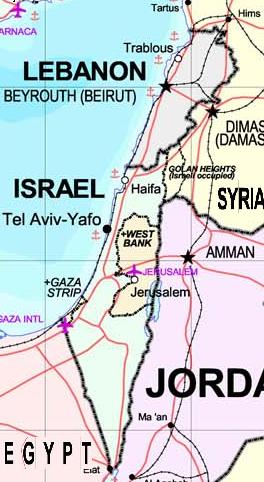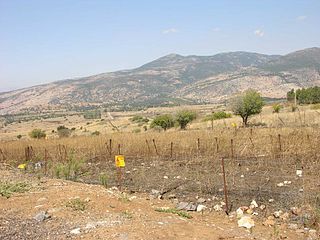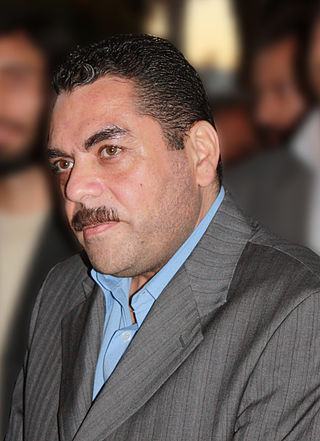Elhanan Tannenbaum, is an Israeli who was kidnapped in 2000 and held for more than three years by the Lebanese militant group Hezbollah. He was released in a prisoner exchange, together with the bodies of several Israeli soldiers, for 435 Arab prisoners held by Israel. After his release from Hezbollah, Tannenbaum was not charged for any crime in Israel, after a plea bargain.

The Blue Line is a demarcation line dividing Lebanon from Israel and the Golan Heights. It was published by the United Nations on 7 June 2000 for the purposes of determining whether Israel had fully withdrawn from Lebanon. It has been described as: "temporary" and "not a border, but a “line of withdrawal”. It is the subject of an ongoing border dispute between Israel, Lebabon, and Hezbollah.

Ehud "Udi" Goldwasser was an Israeli soldier who was abducted in Israel by Hezbollah along with Eldad Regev on 12 July 2006, sparking the 2006 Lebanon War. His rank was First Sergeant.

Eldad Regev was an Israeli soldier abducted by Hezbollah fighters along with Ehud Goldwasser on 12 July 2006 in Israel near the Lebanese border, sparking the 2006 Lebanon War. His rank was Sergeant First Class.
This is a timeline of events related to the 2006 Lebanon War.

The Israeli–Lebanese conflict, or the South Lebanon conflict, is a series of military clashes involving Israel, Lebanon and Syria, the Palestine Liberation Organization, as well as various militias and militants acting from within Lebanon. The conflict peaked in the 1980s, during the Lebanese Civil War, and has abated since.

The South Lebanon conflict, designated by Israel as the Security Zone in Lebanon Campaign, was a protracted armed conflict that took place in southern Lebanon from 1985 to 2000. It saw fighting between Israel and the Catholic Christian-dominated South Lebanon Army (SLA) against Hezbollah-led Shia Muslim and left-wing guerillas within the Israeli-occupied "Security Zone"; the SLA had military and logistical support from the Israel Defense Forces over the course of the conflict and operated under the jurisdiction of the Israeli-backed South Lebanon provisional administration, which succeeded the earlier Israeli-backed State of Free Lebanon. It can also refer to the continuation of the earlier conflict in this region involving the growing Palestinian insurgency in South Lebanon against Israel following the expulsion of the Palestine Liberation Organization (PLO) from Jordan after Black September. Historical tensions between Palestinian refugees and Lebanese factions contributed another layer to the Lebanese Civil War (1975–1990), which saw the Maronite-led Lebanese Front and the Shia Amal Movement at war with the PLO. Hence, the South Lebanon conflict can partly be seen as an extension of the civil war that ended in 1990.

The Battle of Bint Jbeil was one of the main battles of the 2006 Lebanon War. Bint Jbeil is a major town of some 20,000 inhabitants in Southern Lebanon. Although Brig.-Gen. Gal Hirsch announced on 25 July that the Israel Defense Forces (IDF) had "complete control" of Bint Jbeil, this statement was later discredited. In spite of three sustained attempts by the IDF to conquer the town, it remained in the hands of Hezbollah until the end of the war. The town was the scene of some of the fiercest fighting of the war, with both sides taking heavy losses. Three senior Israeli officers, including Major Roi Klein, were killed in the battle. Hezbollah similarly lost several commanders, most notably Khalid Bazzi, commander of the Bint Jbeil area.
During the 2006 Lebanon War, Operation Sharp and Smooth, also known as the Baalbek operation, was an Israel Defense Forces (IDF) raid on a hospital in the city of Baalbek, which was being used as a Hezbollah headquarters, and a neighbourhood of the city. The precise objectives of the raid remain classified, but it is known that a number of Lebanese, including Hezbollah and armed Lebanese Communist Party members, were killed, and five Lebanese civilians were arrested and detained in Israel as suspected Hezbollah members, but released after three weeks. The casualty figures for the raid vary. According to inquiries by Human Rights Watch (HRW) and Lebanese authorities 16 Lebanese residents, most of them civilians, were killed. According to IDF ten Hezbollah militants were killed in the attack.

The 2006 Hezbollah cross-border raid was a cross-border attack carried out by Lebanon-based Hezbollah militants on an Israeli military patrol on 12 July 2006 on Israeli territory.

The 2006 Lebanon War, also called the 2006 Israel–Hezbollah War and known in Lebanon as the July War and in Israel as the Second Lebanon War, was a 34-day military conflict in Lebanon, northern Israel and the Golan Heights. The principal parties were Hezbollah paramilitary forces and the Israel Defense Forces (IDF). The conflict started on 12 July 2006, and continued until a United Nations-brokered ceasefire went into effect in the morning on 14 August 2006, though it formally ended on 8 September 2006 when Israel lifted its naval blockade of Lebanon. Due to unprecedented Iranian military support to Hezbollah before and during the war, some consider it the first round of the Iran–Israel proxy conflict, rather than a continuation of the Arab–Israeli conflict.
The Battle of Ayta ash-Sha'b took place during the 2006 Lebanon War, when the Israel Defense Forces and the Islamic Resistance, the armed wing of Hezbollah, fought a 33 days battle for the town of Ayta ash-Sha'b and the neighboring villages of Ramiya, al-Qawzah and Dibil in southern Lebanon. The initial phase of the battle consisted of two and a half weeks of intense bombardment by air and artillery, followed by more than two weeks of intensive fighting in and around the town. The IDF deployed five brigades against an Hizbullah force consisting of litte more than half a company. Still the IDF failed to capture the town and suffered relatively heavy casualties in the process.
Hezbollah has a military branch and is the sponsor of a number of lesser-known groups, some of which may be little more than fronts for Hezbollah itself. These groups include the Organization of the Oppressed, the Revolutionary Justice Organization, the Organization of Right Against Wrong, and Followers of the Prophet Muhammad.

The 2000–2006 Shebaa Farms conflict was a low-level border conflict between Israel and Hezbollah for control of Shebaa Farms, a disputed territory located on the Golan Heights–Lebanon border. Fighting between the two sides primarily consisted of Hezbollah rocket and mortar attacks on Israel and Israeli artillery barrages and airstrikes on Hezbollah in southern Lebanon. Clashes began a few months after the 2000 Israeli withdrawal from Lebanon, which Hezbollah viewed as incomplete due to the presence of the Israel Defense Forces in Shebaa Farms. The conflict culminated in the 2006 Lebanon War; Israel retains control over the territory.

Samir Kuntar was a Lebanese Druze member of the Palestine Liberation Front and Hezbollah. He was convicted of terrorism and murder by an Israeli court. After his release from prison as part of the 2008 Israel–Hezbollah prisoner exchange, he received Syria's highest medal, was honored by Iranian President Mahmoud Ahmadinejad, and was designated a Specially Designated Global Terrorist by the US government.

The 2005 Hezbollah cross-border raid was a failed attempt by Hezbollah to abduct Israel Defense Forces (IDF) soldiers. It was the largest operation of this type mounted prior to the 2006 Lebanon War.

The 2006 Gaza cross-border raid was an armed incursion carried out by seven or eight Gazan Palestinian militants on 25 June 2006 who attacked Israel Defense Forces (IDF) positions near the Kerem Shalom Crossing through an attack tunnel. In the attack, two IDF soldiers and two Palestinian militants were killed, four IDF soldiers were wounded, one of whom was Gilad Shalit, who was captured and taken to the Gaza Strip.

The Hannibal Directive is the name of a controversial procedure that was used by Israeli Defense Forces (IDF) until 2016 to prevent the capture of Israeli soldiers by enemy forces. According to one version, it says that "the kidnapping must be stopped by all means, even at the price of striking and harming our own forces." It was introduced in 1986, after a number of abductions of IDF soldiers in Lebanon and subsequent controversial prisoner exchanges. The full text of the directive was never published, and until 2003, Israeli military censorship forbade any discussion of the subject in the press. The directive has been changed several times, until it was officially revoked in 2016 by IDF chief of staff Gadi Eizenkot. The Directive's replacement has not been published.

As a response to an Israeli attack against a military convoy comprising Hezbollah and Iranian officers on January 18, 2015 at Quneitra in southern Syria, the Lebanese Hezbollah group launched an ambush on January 28 against an Israeli military convoy in the Israeli-occupied Shebaa Farms, firing anti-tank missiles against two Israeli Humvees patrolling the border, destroying the two Humvees and killing 2 and wounding 7 Israeli soldiers, according to Israeli military. The number of Israeli casualties was 15 according to a report by Al Mayadeen television station. A Spanish UN peacekeeper was also killed by Israeli fire during consequent fire exchanges in the area, with Israel firing artillery and Hezbollah responding by mortar shells. The conflict ended later the same day after UNIFIL mediation.













